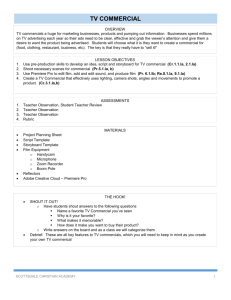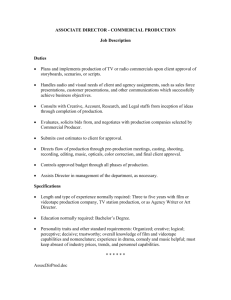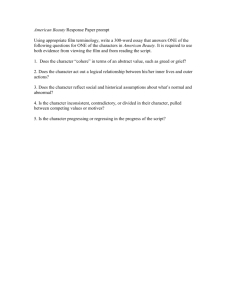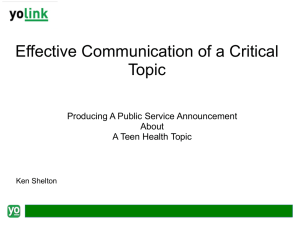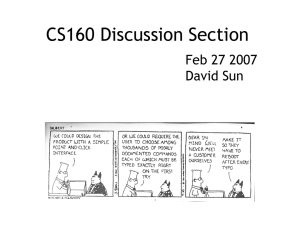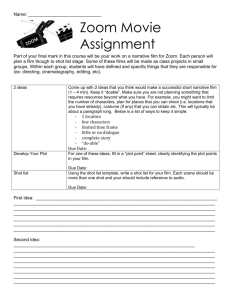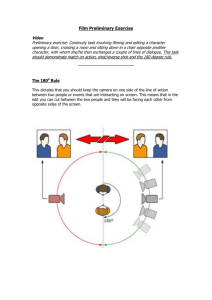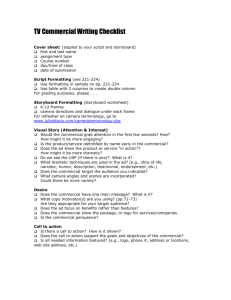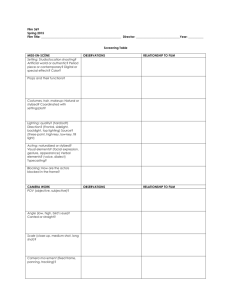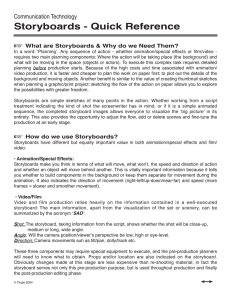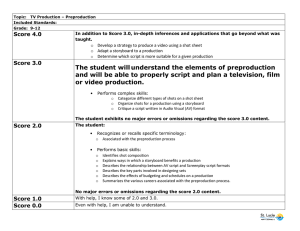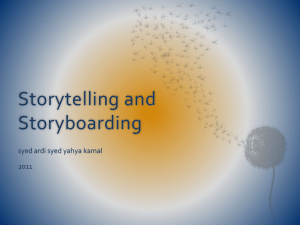Handout
advertisement
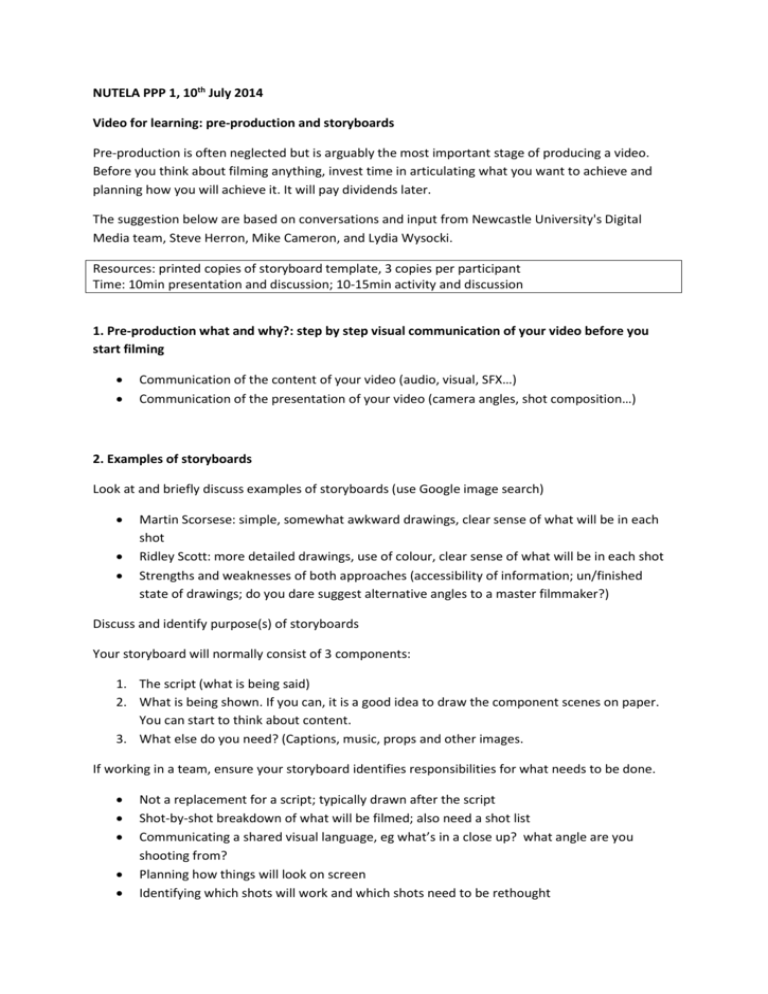
NUTELA PPP 1, 10th July 2014 Video for learning: pre-production and storyboards Pre-production is often neglected but is arguably the most important stage of producing a video. Before you think about filming anything, invest time in articulating what you want to achieve and planning how you will achieve it. It will pay dividends later. The suggestion below are based on conversations and input from Newcastle University's Digital Media team, Steve Herron, Mike Cameron, and Lydia Wysocki. Resources: printed copies of storyboard template, 3 copies per participant Time: 10min presentation and discussion; 10-15min activity and discussion 1. Pre-production what and why?: step by step visual communication of your video before you start filming Communication of the content of your video (audio, visual, SFX…) Communication of the presentation of your video (camera angles, shot composition…) 2. Examples of storyboards Look at and briefly discuss examples of storyboards (use Google image search) Martin Scorsese: simple, somewhat awkward drawings, clear sense of what will be in each shot Ridley Scott: more detailed drawings, use of colour, clear sense of what will be in each shot Strengths and weaknesses of both approaches (accessibility of information; un/finished state of drawings; do you dare suggest alternative angles to a master filmmaker?) Discuss and identify purpose(s) of storyboards Your storyboard will normally consist of 3 components: 1. The script (what is being said) 2. What is being shown. If you can, it is a good idea to draw the component scenes on paper. You can start to think about content. 3. What else do you need? (Captions, music, props and other images. If working in a team, ensure your storyboard identifies responsibilities for what needs to be done. Not a replacement for a script; typically drawn after the script Shot-by-shot breakdown of what will be filmed; also need a shot list Communicating a shared visual language, eg what’s in a close up? what angle are you shooting from? Planning how things will look on screen Identifying which shots will work and which shots need to be rethought 3. Seven questions to consider before you start 1. What are you trying to achieve? What is the intended learning outcome? What will viewers understand, know or do after watching the video? 2. What does your audience care about? How will you relate your message in this context? What will encourage them to watch it in the first place? How will you hook them? 3. What quality do you need to convey your message? Think about both content and production values. What do you need to convey visually? Do you need sound? 4. How are you going to distribute the materials? This will also help determine quality. If lots of people will see it, the production values need to be higher. If it is for a few people, the quality of the content may be all that matters. 5. What resources do you have? Do you need a skilled production crew or a studio? What equipment can you use? Do you have a budget? Can you find creative commons licensed music and images to intercut with your material? 6. What is your 'concept' or narrative for communicating the key message? Is there a visual metaphor or trigger question to engage your audience? How will you grab viewers’ attention in the first 15 seconds? Discuss these ideas with colleagues, your target audience and the film crew. 7. What style and length do you have in mind? Can you find examples? What resource was needed to produce these films? How long will the film be? As a rule of thumb, keep it short (less than 5 minutes). Make every second count, especially the first 15 seconds. This is by no means a definitive list. Can you think of any anything else? 4. Activity Start working on a storyboard for your video o for a video project you’re planning o for a hypothetical video for academic staff new to NU, giving them a tour of your academic unit/service o from memory, work on a storyboard that recreates a section of a film/tv show/advert that is memorable to you Use as many sheets as you need – doesn’t have to fit into 4-panel chunks Use the panels (boxes) to draw what you can (Scorsese style or Ridley Scott style); label items, use arrows to show movement Use the lines to make any additional notes 5. Dealbreakers and practicalities What if: It rains? People aren't good on camera? The general public get in the way? People you film decide they don’t want to let you use the film after all? Control what you can by planning the shoot: 1. Do screen tests with anyone who will be on camera. What works best for them? Do they need a script? Is a rough or tight script appropriate? Will they need several takes? 2. Do a recce. What angles and framing can you get on what needs to be shot? What is the light like? What about the acoustics? Do you need microphones, professional lighting? You can test some things out with a mobile phone camera to see what works before the real shoot. 3. For anyone being filmed, get consent forms filled in in advance 4. Ensure you have written permission to film in the location 5. What pick up, close up, tracking and cutaway shots will you need? How can you give the viewer context about the location? They will be less distracted by noises and other background scenery if they are expecting it. 6. Allow lots of time for setting up and dismantling kit, particularly if filming with a film crew. 7. Plan to shoot in the most efficient order, not necessary the chronological order 8. Allow at least an hour on location for a simple 5 minute shoot. If you need more complex shots, allow even more time. 6. List of resources to email participants after this 3P session. Full list of questions to consider before you start (in this session plan) Full list of practicalities and dealbreakers to plan for (in this session plan) Information about key filming contacts at NU.
